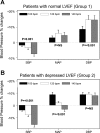The acute effect of atrioventricular pacing on sympathetic nerve activity in patients with normal and depressed left ventricular function
- PMID: 18586896
- PMCID: PMC2544507
- DOI: 10.1152/ajpheart.91404.2007
The acute effect of atrioventricular pacing on sympathetic nerve activity in patients with normal and depressed left ventricular function
Abstract
Although modest elevations in pacing rate improve cardiac output and induce reflex sympathoinhibition, the threshold rate above which hemodynamic perturbations induce reflex sympathoexcitation remains unknown. Systolic blood pressure (SBP), diastolic blood pressure (DBP), and mean arterial pressures (MAP) and sympathetic nerve activity (SNA) were measured during normal sinus rhythm (NSR) and atrioventricular (AV) sequential pacing in 25 patients. Pacing was performed at 100, 120, and 140 beats/min with an AV interval of 100 ms. Patients were divided into two groups based on normal or abnormal left ventricular ejection fraction (LVEF): group 1 (n = 11; mean LVEF, 55%) and group 2 (n = 14; mean LVEF, 31%). In group 1, relative to NSR, SBP decreased an average of 2%, 3%, and 8% at 100, 120, and 140 beats/min (P < 0.001), respectively. DBP and MAP increased 9%, 15%, and 15% (P = 0.001) and 3%, 6%, and 5% [P = not significant (NS)], respectively. In group 2, SBP reductions were even greater, with an average decrease of 4%, 8%, and 16% (P < 0.001). Whereas DBP increased 9%, 9%, and 8% at 100, 120, and 140 beats/min (P = NS), MAP increased 3% and 2% at 100 and 120 beats/min but decreased 3% at 140 beats/min (P = 0.001). SNA recordings were obtained in 11 patients (6 in group 1 and 5 in group 2). In group 1, SNA decreased during all rates, with a mean 21% reduction. In group 2, however, SNA decreased at 100 and 120 beats/min (49% and 38%) but increased 24% at 140 beats/min. Patients with depressed LVEF exhibited altered hemodynamic and sympathetic responses to rapid sequential pacing. The implications of these findings in device programming and arrhythmia rate control await future studies.
Figures




References
-
- Al-Hesayen A, Parker JD. Adverse effects of atrioventricular synchronous right ventricular pacing on left ventricular sympathetic activity, efficiency, and hemodynamic status. Am J Physiol Heart Circ Physiol 291: H2377–H2379, 2006. - PubMed
-
- Erlebacher JA, Danner RL, Stelzer PE. Hypotension with ventricular pacing: an atria vasodepressor reflex in human beings. J Am Coll Cardiol 4: 550–555, 1984. - PubMed
-
- Gohl K, Perl S, Wortmann A, Bachmann K. Haemodynamic analysis of atrioventricular tachycardia. Eur Heart J 13, Suppl E: 99–103, 1992. - PubMed
-
- Goldreyer BN, Kastor JA, Kershbaum KL. The hemodynamic effects of induced supraventricular tachycardia in man. Circulation 54: 783–789, 1976. - PubMed
-
- Hamdan MH, Zagrodzky JD, Page RL, Wasmund SL, Sheehan CJ, Adamson MM, Joglar JA, Smith ML. Effect of P-wave timing during supraventricular tachycardia on the hemodynamic and sympathetic neural response. Circulation 103: 96–101, 2001. - PubMed
Publication types
MeSH terms
Grants and funding
LinkOut - more resources
Full Text Sources
Research Materials
Miscellaneous

